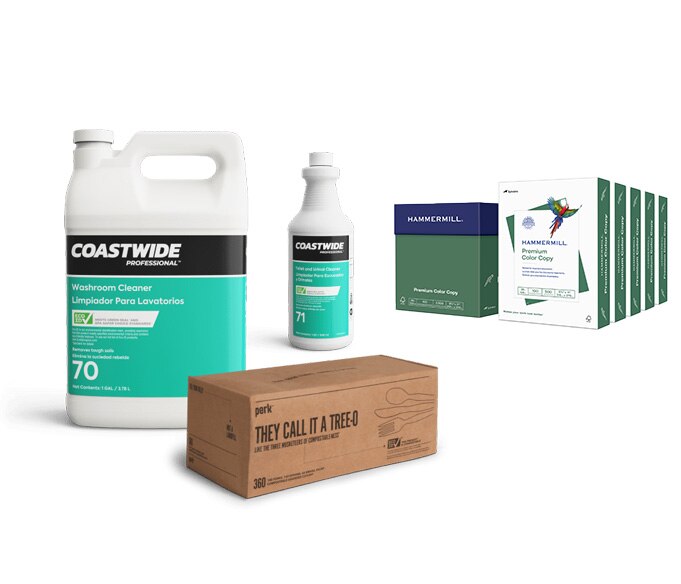Sustainability
Staples is focused on delivering more sustainable products and solutions for our customers and operating our business in a responsible way.
Staples employees plant trees in their local community.
reduction in operational carbon emissions.
of our suppliers having set carbon emissions reduction targets.
diversion of waste to recycling in our fulfillment centers.
Read all about these programs and more in our 2024 Corporate Social Responsibility Report.
20K+
products with
one or more
environmental
features.
Products and
shopping experience
Our customers are looking for eco-preferable products and easy ways to identify and shop for them.
We carry over 20,000 products online with eco features and make it easy to find them with easy-to-see eco icons and enhanced search and filtering capabilities. We’ve also created sustainability centers on staples.com and Staples Business Advantage®.
Visit Staples.com sustainability center
Visit StaplesBusinessAdvantage.com sustainability center
Our Eco-ID‐ program makes it simple to find eco-preferable products. To earn the Eco-ID badge, products need to meet specific eco design criteria, like containing minimum amounts of recycled content or achieving environmental certifications recommended by credible third-party organizations like the U.S. Environmental Protection Agency (EPA).
More than 8,000 items meet Eco-ID criteria today and Eco-ID products represented 23% of our sales in 2023. View the full Eco-ID criteria at www.staples.com/lp/eco-id-program
23%
of our product
sales in 2023
earned our
Eco-ID badge.
23%
of our product
sales in 2023
earned our
Eco-ID badge.
Customer recycling services
We proudly recycle technology, printer cartridges, batteries, used writing tools and much more in every Staples‐ retail store.
Our stores have a strong history supporting sustainability, with free recycling for office electronics since 2012. Since 2012, we've recycled 188,097,689 pounds of technology. In 2022 we began offering rewards for recycling in store and at staples.com.
Learn more about retail recycling
In our Staples Business Advantage division, we offer customer recycling programs for ink and toner, electronics, rechargeable batteries, and many other items via a zero-waste box recycling program. Our free ink and toner recycling program supports customers with multiple options, including driver pickup, mailing labels, drop off in-store, and box programs. We provide electronics recycling services to business customers with easy mail-back box programs and dedicated pickups in collaboration with our national partner. Our Staples Business Advantage facilities team also works with customers to help them implement programs to reduce waste, including supporting composting and zero waste programs in breakrooms and other areas.
Learn more about our Staples Business Advantage recycling programs
Supplier engagement
We don't just hold ourselves to high standards; we encourage our suppliers to employ sustainable practices and to adhere to our policies including our Sustainability Policy, Paper and Wood-Product Sourcing Policy, Chemicals Policy, and Supplier Code of Conduct. We also participate in several groups with suppliers and customers to learn, collaborate, and advance our progress including the Sustainable Purchasing Leadership Council, Sustainable Packaging Coalition, and the Green Chemistry and Commerce Council.
In 2022 we launched a new supplier assessment process to gather information about the environmental and social practices of suppliers providing us with products and services. This assessment will allow us to better evaluate sustainability performance of suppliers selling us products, understand how suppliers are integrating environmental and social responsibility into their operations, and identify areas for collaboration and improvement.
Delivery
We actively work to reduce the environmental impacts of our delivery network, including deploying fleet telematics, electric vehicles, order packaging technology and order consolidation strategies.
London, Ohio Fulfillment Center
Energy and climate
Staples has been working on energy efficiency and climate issues for many years.
Measures we take to boost efficiency in our buildings include:
- Using lower wattage lighting and more efficient LED lamps
- Installing motion sensors for occupancy and daylight harvesting
- Optimizing energy management systems to control lighting and HVAC
- Using variable-speed drives on HVAC and other equipment
- Participating in energy consumption demand response programs
In 2021 we established a goal to reduce our operational (Scope 1&2) greenhouse gas emissions by 35% by 2028 from a 2021 baseline. We also committed to get 70% of our vendors by spend to set emissions reductions targets by 2028. We’re excited to share that the Science Based Targets initiative (SBTi) approved Staples Inc.’s near-term science-based emissions reduction targets.
Thanks to our energy efficiency focus and the adoption of cleaner energy sources by the utilities who serve us, we have driven significant reductions in energy-related carbon emissions in support of our 2028 goal. In fact, Staples Inc. achieved a 24% absolute reduction in Scope 1 and 2 emissions from 2021‐2023.
The fiscal year 2023 emissions for Staples U.S. Delivery are listed below.
Scope 1 = 31,072 MT CO2e
Scope 2 (Market Based) = 33,583 MT CO2e
Scope 2 (Location Based) = 35,388 MT CO2e
Scope 3 = 3,925,792 MT CO2e
Biogenic: 1858 MT CO2e
Learn more about each scope of emissions
Staples, Inc. conducts an annual carbon inventory in which it finalizes its carbon emissions for the past fiscal year. The inventory's methodology follows that of the Greenhouse Gas Protocol. The annual inventories serve as the basis for Staples, Inc.'s approved science-based targets, including claims regarding carbon reductions. Staples, Inc. does not purchase voluntary carbon offsets at this time. Annual inventories have not been verified by an independent third party at this time.
Waste reduction
All Staples warehouses and retail locations have recycling programs for cardboard, plastic films, mixed metals, pallets, and mixed paper. We also have programs to manage the small amounts of hazardous waste that are generated in our facilities.
Our initiatives to reduce waste and increase recycling include waste audits to identify key opportunities, centralizing waste contracts, and reallocating recycling equipment to boost participation.
35% reduction in our operational carbon emissions (from a 2021 baseline)
This is part of our SBTi-approved near-term science-based emissions reduction target.
To achieve this goal, we will:
- Increase the energy efficiency of our buildings
- Continue to electrify our fleet and boost its efficiency
- Procure renewable electricity
70% of our suppliers (by spend) having set carbon emissions reduction targets aligned with climate science
This is part of our SBTi-approved near-term science-based emissions reduction target.
This goal addresses the emissions associated with the companies we use to run our business.
These emissions are higher than those from our direct operations.
To achieve this goal, we will:
- Encourage our suppliers to set carbon emissions goals in line with climate science
- Track their progress on these goals and connect them with resources if necessary
90% diversion of waste to recycling in our warehouses
Our facilities are already diverting waste to recycling today, but we know there are still opportunities to improve our performance.
To achieve this goal, we will:
- Identify key areas for improvement and implement programs to address them
- Ensure all facilities have transparency and recognition for high performance
Policies and documents
Our sustainability policies and other documentation are available here:
• Staples Supplier Code of Conduct • Staples Sustainability Policy • Staples Paper and Wood-Product Sourcing Policy • Staples Chemicals Policy • Staples Priority Chemicals of Concern List









